|
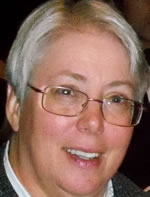 AUTISM
AWARENESS MONTH, APRIL 2010 AUTISM
AWARENESS MONTH, APRIL 2010
Written by:
Kathy Brinker (bio)
April was Autism awareness month. No
other disability group has such a national
emphasis over a month’s time on
awareness, research, fundraising, and
best practices. Pediatricians have been
inundated with screenings and information
to help them with early diagnosis (visit
know
the signs). Recent CDC reports (2007)
conservatively report the rates at 1:150.
It is by far the fastest growing developmental
disability group. Wow!
Yet, sadly, we still have a lot of
work to do in educating physical educators
as to the best practices for working
with individuals with autism. Physical
Education is a highly stimulating environment
with many structural and environmental
concerns for individuals with sensory
needs. Budget cuts find us with fewer
paraprofessionals, more students, and
fewer resources. How do we survive?
The question is: How do we meet the
needs of all students in our classrooms?
Here is my top twelve list of things
that my students with autism would tell
me if they had the language, or from
those who have actually told me!!
- You talk too much.
- You demonstrate too little.
- Stop taking yourself so seriously.
- Make sure the environment is ready
to go before I enter the gym.
- Forecast ahead of time changes in
my routine (especially fire drills!).
- You talk too much (I needed to say
that again!!).
- Make sure you have my favorite color
in every piece of equipment you order.
- Let me feel every piece of equipment
you order before you order it.
- You know motor development, now
learn the strategies that will get
me to where you want to be in my motor
skills. I have a lot to learn in your
class.
- Don’t insist on eye contact,
but do make sure that I am, out of
the corner of my eye, watching the
balls you throw to me.
- I am amazing, taking everything
in and very capable of learning if
presented with the materials in a
way I learn.
- Your music is too loud and you talk
too much!! (Had to say it one more
time).
Start with educating yourself about
the large spectrum known as autism.
Think of it as a rainbow with many different
shades and places along the spectrum
of colors. Amazing breakthroughs will
take place with your students when you
are able to help them make the connections!
Identifying with one student that you
have had in your classes may not necessarily
help you with the next student that
walks into your gym. Autism is a complex
spectrum with many different needs for
each individual. Check out the NICHCY
website What
is autism. Want to have a hard look
at how we are doing in the public school
system in educating students with autism?
Check out Temple
Grandin’s honest assessment
of education. As an individual with
autism, Temple brings us into her world
and gives us a perspective that I wish
I had on every one of my students with
autism.
We are just beginning to scratch the
surface in the area of research in a
physical education setting where students
with autism are concerned. Most studies
cited are case studies involving one
student. Current literature and research
for students with autism continues to
be under the guise of special education.
As physical educators we use verbal
modalities to impart transitions, commenting,
positive specific feedback, and grouping
of students. Our visual prompting is
often left to specific technique in
skill acquisition. Yet, we know from
the research that many students with
autism require visual feedback paired
with auditory. Using the Picture Exchange
Communication System (PECS), pecs
paired with boardmaker
allows physical educators the opportunity
to impart specific commands to students
in a visual manner. Below are a variety
of systems for visual support for students
with autism. Many systems for visual
supports are loosely related to the
TEACCH
system.
There probably are not many questions
about what we are doing today in my
5th hour class after seeing this pictoral
schedule. The only question may be what
music are you playing?

Use the premack principle. Pair a
desired activity with an undesired activity.
For example, if the student digs the
feel of koosh
balls, ask him/her to throw the
football 3 times before receiving the
koosh ball.
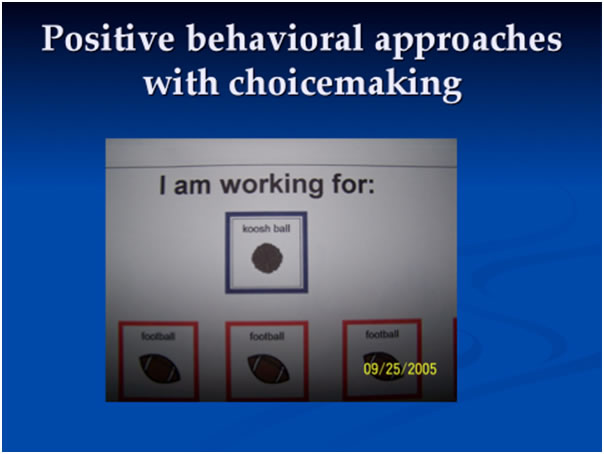
There are many instructional sequences
that we must teach in physical education.
One such sequence is baseball. Here
is an example of an instructional sequence
that is placed on a batting
T to reinforce the correct order
of the sequence. This was made by placing
several boardmaker
pictures together.
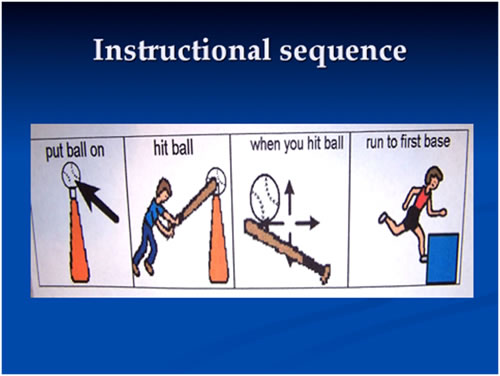
Choicemaking and expressing desired
activities is a skill, which needs to
be taught to some students with autism.
In these choices the student must not
only choose the activity but also a
person whom he/she is going to “play”
with, which also reinforces the social
aspects of play. The bottom sentence
is made by the student saying.. I want
to play ___(activity) with _____ (person).
The strip (red) is then handed by the
student to the person they wish to play
with. Depending on the student, he/she
may need assistance in handing over
the sentence strip.
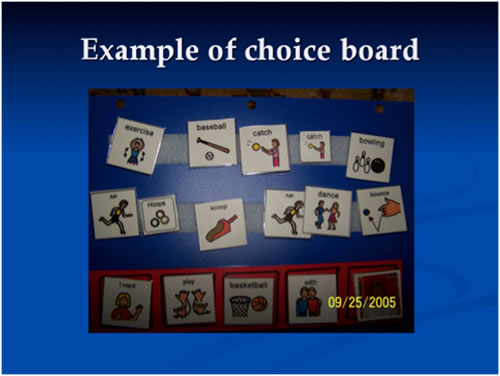
Taking breaks: Students
may get overloaded by all the noise
and confusion in your gym sometimes.
Planning for taking breaks is a great
idea. What should a break look like?
I personally think breaks should be
motor oriented (choose one or make up
your own!). From the list below, identify
which breaks would be calming, and which
breaks would “pump up” the
students’ systems. Students should
request breaks either verbally or by
picture request. Breaks should be limited
in time, and be determined ahead of
time (set a timer). Breaks will allow
the student to control his/her environment
and meet his/her immediate sensory needs
(pump up or calm down). Once the break
is over, the student should return to
activity.
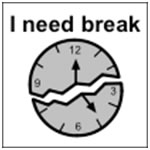
- 10 wall pushups
- walk to get a drink of water
- jump 50 times
- squeeze a ball as hard as you can
20 times
- breath and blow it out 10 times
- push a milk crate of beanbags to
the other side of the gym (heavy work)
Lastly, there are many ways to help
in your community to bring awareness
and money for research in the field
of autism. Check out the following physical
activity events schedules during the
month of April. Bounce
for autism or walk
for autism.
With a little help (collaboration)
from the special educator and speech
pathologist in your building, you can
make a difference each day! By predicting
events to come, allow for choice making
and allowing the student with autism
to take a break when things are stressful.
Many students with autism will be very
successful in your classes. Once you
learn the strategies, spread the word
and help other physical educators to
be successful.
Block, Martin E. (2003). Children with
Asperger Syndrome. Implications for
general education and youth sports.
JOPHERD.Bryan, L. C., & Gast, D.
L. (2000). Teaching
on-task and on-schedule behaviors to
high-functioning children with autism
via picture schedules. Journal
of Autism and Developmental Disorders,
30(6), 553-567.
Charlope-Christy, M., & Haymes,
L. (1998). Using
objects of obsession as token reinforcers
for children with autism. Journal of
Autism and Developmental Disorders,
28(3), 189-198.
Fittipaldi-wert, Jeanine; Claire M.
Mowling. "Using
visual supports for students with autism
in physical education: this comparatively
new communication technique can help
students with autism to succeed in physical
education." JOPERD--The Journal
of Physical Education, Recreation &
Dance. American Alliance for Health,
Physical Education, Recreation and Dance
(AAHPERD). 2009.
Ford, L., Riggs, K. S., Nissenbaum,
M., & LaRaia, J. (1994). Facilitating
desired behavior in children with autism:
A case study. Contemporary Education,
65(3), 148-151.
Gray, C. A., &; Garand, J. D. (1993).
Social
stories: Improving responses of students
with autism with accurate social information.
1'Ocus on Autistic Behavior, 8(1), 1-10.
Jenison Public Schools, Jenison Michigan.The
New Social Story Book. Arlington,
Tx: Future Horizons.
Kim, So-Yeun. "Assessing
physical activity levels of students
with disabilities in physical education?(Editorial)."
JOPERD--The Journal of Physical Education,
Recreation & Dance. American Alliance
for Health, Physical Education, Recreation
and Dance (AAHPERD). 2009
Koenig, Kristie P; Kinnealey, Moya.
"Research
Brief: Sensory, Motor, and Communication
Challenges for Persons With Autism Spectrum
Disorders." Sensory Integration
Special Interest Section Quarterly /
American Occupational Therapy Association.
The American Occupational Therapy Assn,
Inc. 2008.
Liberman, Lauren J. (2003) Strategies
for teaching students with autism in
physical education. JOPHERD.
Menear, Kristi Sayers; Smith, Shannon.
"Physical
Education for Students With Autism:
Teaching Tips and Strategies."
Teaching Exceptional Children. Council
for Exceptional Children. 2008
O’Connor, John, French, R., &
Henderson, H.L. Use
of Physical Activity to Improve Behavior
of Children with Autism. Palestra,
16 (3).
Rosenthal-Malek, A., & Mitchell,
S. (1997). Brief
Report: The effects of exercise on the
self-stimulating behaviors and positive
responding of adolescents with autism.
Journal of Autism and Developmental
Disorders, 27 (2), 193-202.
Weber, R.C., &Thorpe, Joanne (1992).
Teaching
children with autism through task variation
in physical education. Exceptional
Children, 559 (1), 77-86.
Wolfberg, Pamela, J. (2003). Peer
play and Autism Spectrum. Shawnee
Mission, Kansas.:Autism Asperger’s
Publishing Company.
Zhang, Jiabei; Ann J. Griffin. "Including
children with autism in general physical
education: eight possible solutions;
To successfully include students with
autism, you must first believe that
it can be done.(Solutions for Including
Individuals with Disabilities)."
JOPERD--The Journal of Physical Education,
Recreation & Dance. American Alliance
for Health, Physical Education, Recreation
and Dance (AAHPERD). 2007
|



